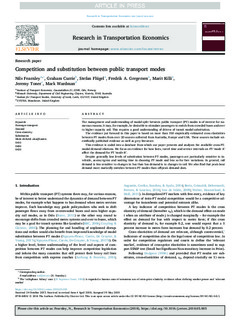| dc.contributor.author | Fearnley, Nils | |
| dc.contributor.author | Currie, Graham | |
| dc.contributor.author | Flugel, Stefan Markus | |
| dc.contributor.author | Gregersen, Fredrik Alexander | |
| dc.contributor.author | Killi, Marit | |
| dc.contributor.author | Toner, Jeremy P | |
| dc.contributor.author | Wardman, Mark | |
| dc.coverage.spatial | Norway | nb_NO |
| dc.date.accessioned | 2019-06-27T10:34:34Z | |
| dc.date.available | 2019-06-27T10:34:34Z | |
| dc.date.created | 2018-05-29T10:41:13Z | |
| dc.date.issued | 2018-05-26 | |
| dc.identifier.citation | Research in Transportation Economics. 2018, 69 (September), 51-58 . | nb_NO |
| dc.identifier.issn | 0739-8859 | |
| dc.identifier.uri | http://hdl.handle.net/11250/2602527 | |
| dc.description.abstract | The management and understanding of modal split between public transport (PT) modes is of interest for numerous reasons. It may, for example, be desirable to stimulate passengers to switch from crowded buses and over to higher capacity rail. This requires a good understanding of drivers of transit modal substitution.
The evidence put forward in this paper is based on more than 150 empirically estimated cross elasticities between PT modes from over 20 sources collected from Australia, Europe and USA. These sources include scientifically published evidence as well as grey literature.
This evidence is coded into a database from which our paper presents and analyses the available cross-PT-modal demand relations. We focus on evidence for how fares, travel time and service intervals on PT ‘mode A’ affect the demand for PT ‘mode B’.
Despite generally low levels of substitution between PT modes, passengers are particularly sensitive to in-vehicle, access/egress and waiting time in choosing PT mode and less so for fare variations. In general, rail demand is less sensitive to changes in bus than bus demand is to changes in rail. We also find that peak-hour demand more markedly switches between PT modes than off-peak demand does. | nb_NO |
| dc.language.iso | eng | nb_NO |
| dc.publisher | Elsevier | nb_NO |
| dc.rights | Attribution-NonCommercial-NoDerivatives 4.0 Internasjonal | * |
| dc.rights.uri | http://creativecommons.org/licenses/by-nc-nd/4.0/deed.no | * |
| dc.title | Competition and substitution between public transport modes | nb_NO |
| dc.title.alternative | Competition and substitution between public transport modes | nb_NO |
| dc.type | Journal article | nb_NO |
| dc.type | Peer reviewed | nb_NO |
| dc.rights.holder | © 2018 The Authors. Published by Elsevier Ltd. | nb_NO |
| dc.description.version | acceptedVersion | nb_NO |
| cristin.unitcode | 7482,1,5,0 | |
| cristin.unitcode | 7482,3,2,0 | |
| cristin.unitcode | 7482,1,1,0 | |
| cristin.unitcode | 7482,3,1,0 | |
| cristin.unitname | Marked og styring | |
| cristin.unitname | Transportmodeller | |
| cristin.unitname | Reisevaner og mobilitet | |
| cristin.unitname | Samfunnsøkonomiske analyser | |
| cristin.ispublished | true | |
| cristin.fulltext | postprint | |
| cristin.qualitycode | 1 | |
| dc.identifier.doi | 10.1016/j.retrec.2018.05.005 | |
| dc.identifier.cristin | 1587350 | |
| dc.source.journal | Research in Transportation Economics | nb_NO |
| dc.source.volume | 69 | nb_NO |
| dc.source.issue | September 2018 | nb_NO |
| dc.source.pagenumber | 51-58 | nb_NO |
| dc.relation.project | Norges forskningsråd: 246836 | nb_NO |

